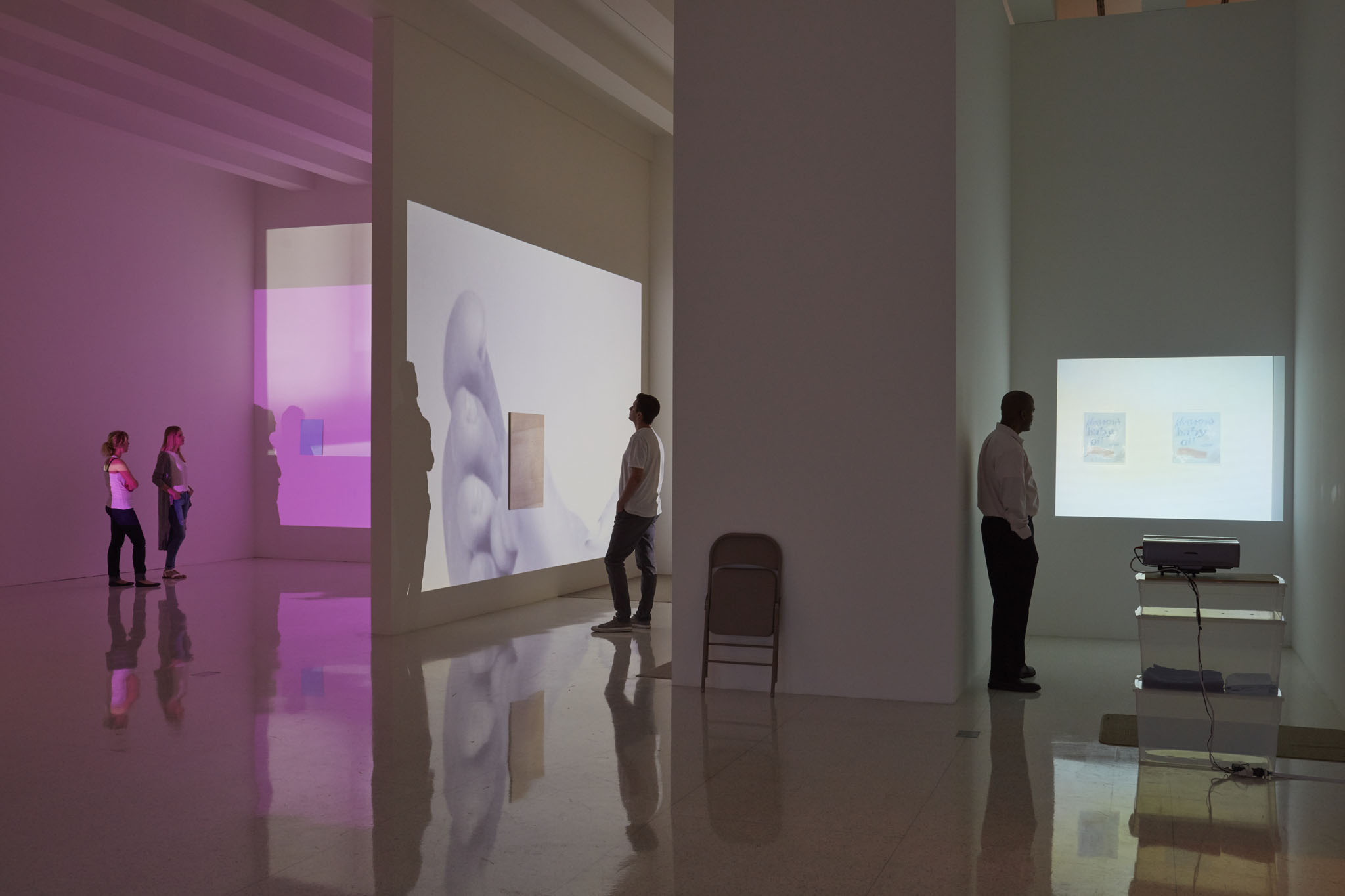Hold your breath, dance slowly at the Walker Art Center Minneapolis.
May 12 – Oct 9, 2016
By Sheila Dickinson
A saccharine, instrumental version of the song Can’t Help Falling in Love greets the viewer on entering the dimly lit rooms built into the Walker Art Center’s large gallery that house Lee Kit’s Hold your breath, dance slowly. Hints of intimate, private spaces occupy each room: a floor lamp, carpet fragments, folding chairs and plastic storage bins with a few household objects in them. The small paintings that dot the walls, looking decorative, reveal a barely visible word, usually a brand name like Johnson or Nivea, or an isolated image such as a hand.
Hold your breath, dance slowly coaxes the viewer with comforting, familiar objects and brands, but these are a ruse, because the exhibition intentionally pushes and pulls the viewer around the space in an uncertain swirl. Floating on the walls of the gallery’s small rooms are projections of colours, shapes and occasional images. The projectors sit low on stacked plastic bins or waist-high podiums, causing the viewer’s body to interfere with and cut silhouettes into the projections. Move in closer to see a painting on the wall and your own shadow obscures it, and you need to move to see the painting in the light, only to be underwhelmed by the word or image revealed. The viewer’s attempt to find something enlightening or profound in the paintings remains unsatisfied – until, that is, they get a slap in the face from a piece on the wall farthest from the entrance; Fuck You (2012) addresses the viewer in soft, elegant writing.

Installation view of Hold your breath, dance slowly by Lee Kit, 2016. Courtesy The Walker Art Centre, Minneapolis.
In his talk at the show’s opening, Lee mentioned his desire to “complicate
commercialised intimacy”. The exhibition contests how Facebook and other social media make us feel intimate with others, profiting from our reliance on screens for a feeling of closeness. Lee forces viewers to interject their bodies into the works, interrupting the screen; they perform within the works rather than just observing them. Your awareness of your own movement and that of other visitors is more interesting than the paintings on the wall. The search for what constitutes the art is never settled. The experience feels similar to scrolling through media feeds, knowing you will never reach a destination. The daily routines of personal care suggested by Lee’s hygiene products mimic our daily obsession with our screens.
One work, I Can’t Help Falling in Love (2012), displays 13 CRT televisions on utilitarian shelves and provides a place to stop and look at them. At random intervals each screen shows common personal-hygiene products, such as a Nivea lotion container or a nail clipper, in domestic scenes in which a person’s given name also occasionally appears. The music seemingly playing overhead, in fact, emanates from this piece. By the time you navigate through the maze of rooms to see this work, its sickly-sweet, wordless music, like that played in the sort of shops where these products are sold, has become irritating, if not distracting, making it hard to focus on one thing.
Like the cloying tune overhead, the outcome of the exhibition is not so much visual, but a pervasive aura that hangs over it and clings to you afterwards. In 10 years after, I grow fatter (2016), displayed at the exit, Lee offers the viewer a readymade of a shower: a mundane, everyday bathroom fixture that like many commercial products promises something it can’t deliver. But the readymade doesn’t do its job of cleansing viewers of their experiences; the concepts of Hold your breath, dance slowly remain salient.
